Impact of Communication Styles on Business Outcomes: A Report
VerifiedAdded on 2021/04/24
|8
|1940
|121
Report
AI Summary
This report analyzes two articles related to business communication. The first article discusses the impact of social media on electoral politics in Indonesia, highlighting the role of social media in creating polarization, spreading misinformation, and fostering tribal nationalism. The second article examines the effects of conversational human voice and source credibility in crisis communication via blogs, emphasizing the importance of a human voice and effective communication strategies in building trust and managing public perception. The report then discusses the conclusions drawn from these two contexts, focusing on communication styles, channels, and intercultural communication, and their impacts on business outcomes. It emphasizes the negative impacts of social media on intercultural communication in electoral campaigns and highlights the benefits of using human voice in crisis communication. Finally, the report discusses the significance of effective communication in managing crises and building strong relationships with consumers.
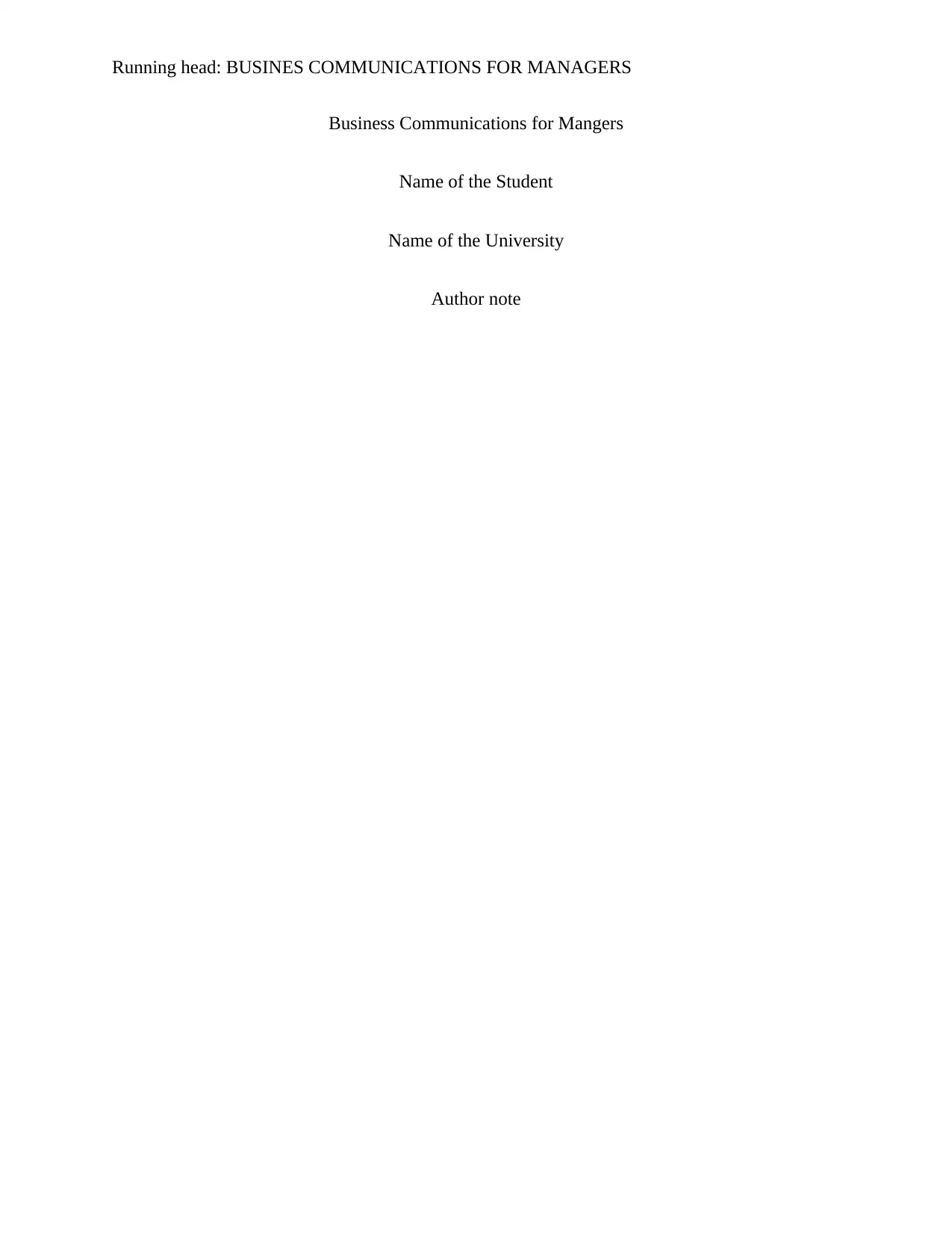
Running head: BUSINES COMMUNICATIONS FOR MANAGERS
Business Communications for Mangers
Name of the Student
Name of the University
Author note
Business Communications for Mangers
Name of the Student
Name of the University
Author note
Paraphrase This Document
Need a fresh take? Get an instant paraphrase of this document with our AI Paraphraser
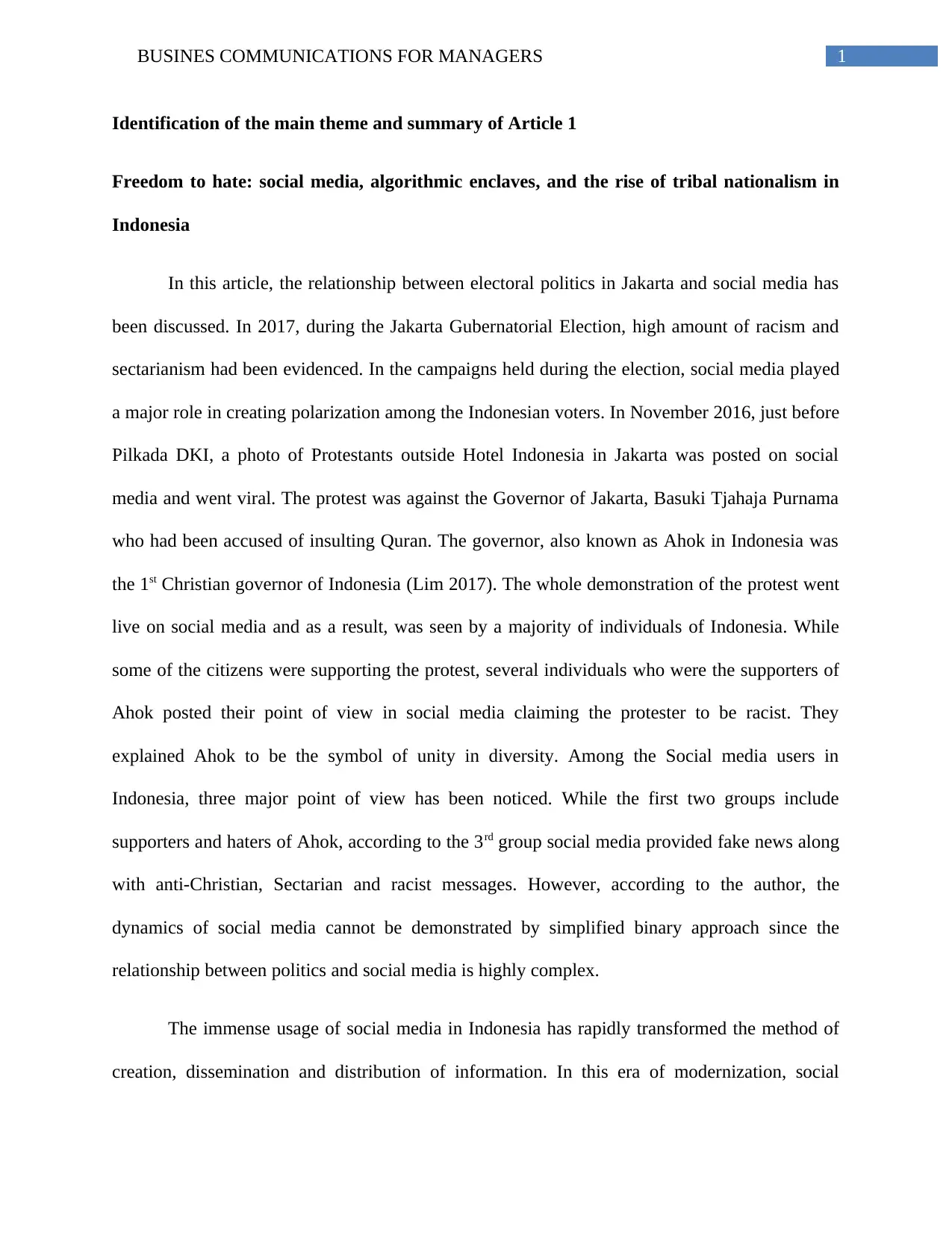
1BUSINES COMMUNICATIONS FOR MANAGERS
Identification of the main theme and summary of Article 1
Freedom to hate: social media, algorithmic enclaves, and the rise of tribal nationalism in
Indonesia
In this article, the relationship between electoral politics in Jakarta and social media has
been discussed. In 2017, during the Jakarta Gubernatorial Election, high amount of racism and
sectarianism had been evidenced. In the campaigns held during the election, social media played
a major role in creating polarization among the Indonesian voters. In November 2016, just before
Pilkada DKI, a photo of Protestants outside Hotel Indonesia in Jakarta was posted on social
media and went viral. The protest was against the Governor of Jakarta, Basuki Tjahaja Purnama
who had been accused of insulting Quran. The governor, also known as Ahok in Indonesia was
the 1st Christian governor of Indonesia (Lim 2017). The whole demonstration of the protest went
live on social media and as a result, was seen by a majority of individuals of Indonesia. While
some of the citizens were supporting the protest, several individuals who were the supporters of
Ahok posted their point of view in social media claiming the protester to be racist. They
explained Ahok to be the symbol of unity in diversity. Among the Social media users in
Indonesia, three major point of view has been noticed. While the first two groups include
supporters and haters of Ahok, according to the 3rd group social media provided fake news along
with anti-Christian, Sectarian and racist messages. However, according to the author, the
dynamics of social media cannot be demonstrated by simplified binary approach since the
relationship between politics and social media is highly complex.
The immense usage of social media in Indonesia has rapidly transformed the method of
creation, dissemination and distribution of information. In this era of modernization, social
Identification of the main theme and summary of Article 1
Freedom to hate: social media, algorithmic enclaves, and the rise of tribal nationalism in
Indonesia
In this article, the relationship between electoral politics in Jakarta and social media has
been discussed. In 2017, during the Jakarta Gubernatorial Election, high amount of racism and
sectarianism had been evidenced. In the campaigns held during the election, social media played
a major role in creating polarization among the Indonesian voters. In November 2016, just before
Pilkada DKI, a photo of Protestants outside Hotel Indonesia in Jakarta was posted on social
media and went viral. The protest was against the Governor of Jakarta, Basuki Tjahaja Purnama
who had been accused of insulting Quran. The governor, also known as Ahok in Indonesia was
the 1st Christian governor of Indonesia (Lim 2017). The whole demonstration of the protest went
live on social media and as a result, was seen by a majority of individuals of Indonesia. While
some of the citizens were supporting the protest, several individuals who were the supporters of
Ahok posted their point of view in social media claiming the protester to be racist. They
explained Ahok to be the symbol of unity in diversity. Among the Social media users in
Indonesia, three major point of view has been noticed. While the first two groups include
supporters and haters of Ahok, according to the 3rd group social media provided fake news along
with anti-Christian, Sectarian and racist messages. However, according to the author, the
dynamics of social media cannot be demonstrated by simplified binary approach since the
relationship between politics and social media is highly complex.
The immense usage of social media in Indonesia has rapidly transformed the method of
creation, dissemination and distribution of information. In this era of modernization, social
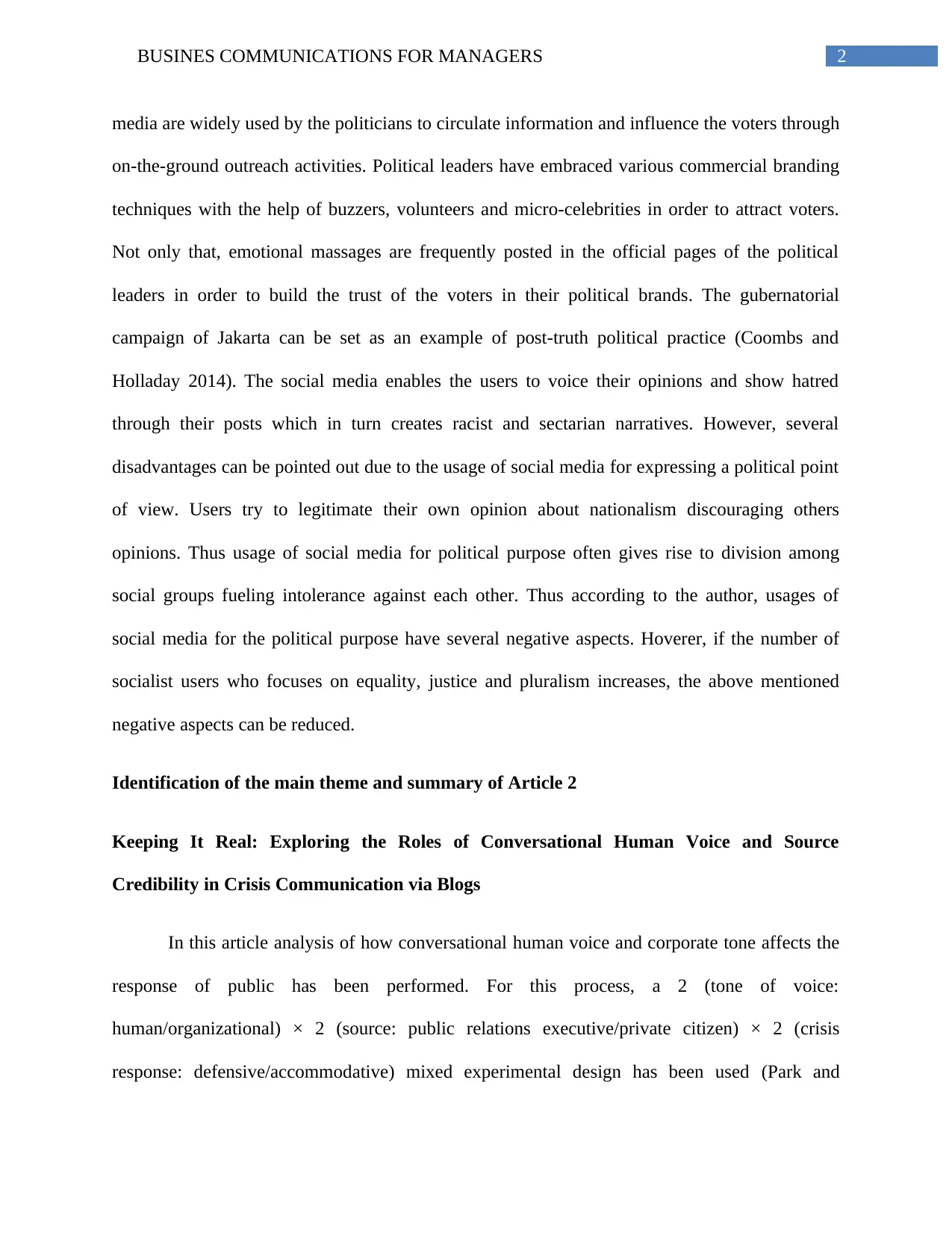
2BUSINES COMMUNICATIONS FOR MANAGERS
media are widely used by the politicians to circulate information and influence the voters through
on-the-ground outreach activities. Political leaders have embraced various commercial branding
techniques with the help of buzzers, volunteers and micro-celebrities in order to attract voters.
Not only that, emotional massages are frequently posted in the official pages of the political
leaders in order to build the trust of the voters in their political brands. The gubernatorial
campaign of Jakarta can be set as an example of post-truth political practice (Coombs and
Holladay 2014). The social media enables the users to voice their opinions and show hatred
through their posts which in turn creates racist and sectarian narratives. However, several
disadvantages can be pointed out due to the usage of social media for expressing a political point
of view. Users try to legitimate their own opinion about nationalism discouraging others
opinions. Thus usage of social media for political purpose often gives rise to division among
social groups fueling intolerance against each other. Thus according to the author, usages of
social media for the political purpose have several negative aspects. Hoverer, if the number of
socialist users who focuses on equality, justice and pluralism increases, the above mentioned
negative aspects can be reduced.
Identification of the main theme and summary of Article 2
Keeping It Real: Exploring the Roles of Conversational Human Voice and Source
Credibility in Crisis Communication via Blogs
In this article analysis of how conversational human voice and corporate tone affects the
response of public has been performed. For this process, a 2 (tone of voice:
human/organizational) × 2 (source: public relations executive/private citizen) × 2 (crisis
response: defensive/accommodative) mixed experimental design has been used (Park and
media are widely used by the politicians to circulate information and influence the voters through
on-the-ground outreach activities. Political leaders have embraced various commercial branding
techniques with the help of buzzers, volunteers and micro-celebrities in order to attract voters.
Not only that, emotional massages are frequently posted in the official pages of the political
leaders in order to build the trust of the voters in their political brands. The gubernatorial
campaign of Jakarta can be set as an example of post-truth political practice (Coombs and
Holladay 2014). The social media enables the users to voice their opinions and show hatred
through their posts which in turn creates racist and sectarian narratives. However, several
disadvantages can be pointed out due to the usage of social media for expressing a political point
of view. Users try to legitimate their own opinion about nationalism discouraging others
opinions. Thus usage of social media for political purpose often gives rise to division among
social groups fueling intolerance against each other. Thus according to the author, usages of
social media for the political purpose have several negative aspects. Hoverer, if the number of
socialist users who focuses on equality, justice and pluralism increases, the above mentioned
negative aspects can be reduced.
Identification of the main theme and summary of Article 2
Keeping It Real: Exploring the Roles of Conversational Human Voice and Source
Credibility in Crisis Communication via Blogs
In this article analysis of how conversational human voice and corporate tone affects the
response of public has been performed. For this process, a 2 (tone of voice:
human/organizational) × 2 (source: public relations executive/private citizen) × 2 (crisis
response: defensive/accommodative) mixed experimental design has been used (Park and
⊘ This is a preview!⊘
Do you want full access?
Subscribe today to unlock all pages.

Trusted by 1+ million students worldwide
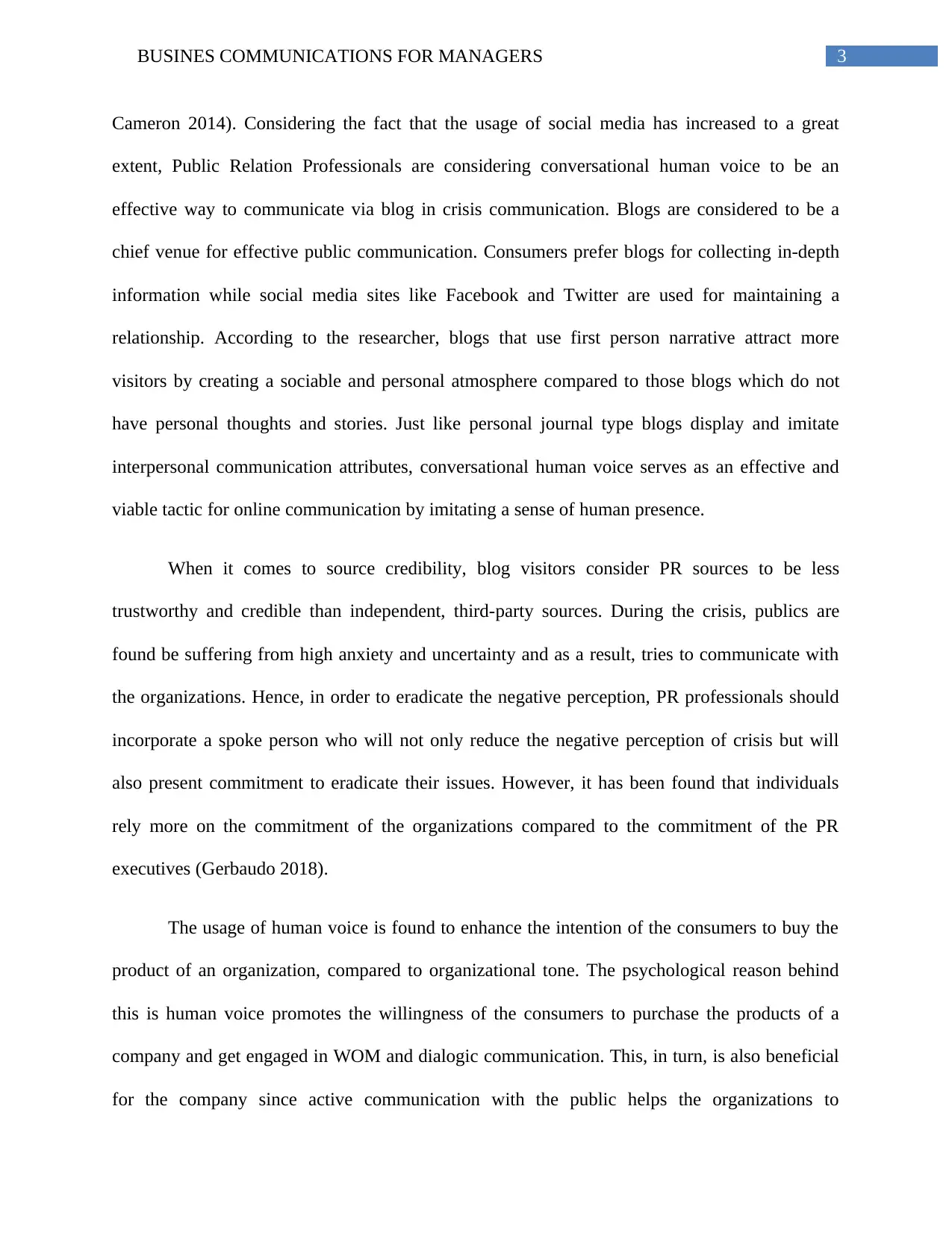
3BUSINES COMMUNICATIONS FOR MANAGERS
Cameron 2014). Considering the fact that the usage of social media has increased to a great
extent, Public Relation Professionals are considering conversational human voice to be an
effective way to communicate via blog in crisis communication. Blogs are considered to be a
chief venue for effective public communication. Consumers prefer blogs for collecting in-depth
information while social media sites like Facebook and Twitter are used for maintaining a
relationship. According to the researcher, blogs that use first person narrative attract more
visitors by creating a sociable and personal atmosphere compared to those blogs which do not
have personal thoughts and stories. Just like personal journal type blogs display and imitate
interpersonal communication attributes, conversational human voice serves as an effective and
viable tactic for online communication by imitating a sense of human presence.
When it comes to source credibility, blog visitors consider PR sources to be less
trustworthy and credible than independent, third-party sources. During the crisis, publics are
found be suffering from high anxiety and uncertainty and as a result, tries to communicate with
the organizations. Hence, in order to eradicate the negative perception, PR professionals should
incorporate a spoke person who will not only reduce the negative perception of crisis but will
also present commitment to eradicate their issues. However, it has been found that individuals
rely more on the commitment of the organizations compared to the commitment of the PR
executives (Gerbaudo 2018).
The usage of human voice is found to enhance the intention of the consumers to buy the
product of an organization, compared to organizational tone. The psychological reason behind
this is human voice promotes the willingness of the consumers to purchase the products of a
company and get engaged in WOM and dialogic communication. This, in turn, is also beneficial
for the company since active communication with the public helps the organizations to
Cameron 2014). Considering the fact that the usage of social media has increased to a great
extent, Public Relation Professionals are considering conversational human voice to be an
effective way to communicate via blog in crisis communication. Blogs are considered to be a
chief venue for effective public communication. Consumers prefer blogs for collecting in-depth
information while social media sites like Facebook and Twitter are used for maintaining a
relationship. According to the researcher, blogs that use first person narrative attract more
visitors by creating a sociable and personal atmosphere compared to those blogs which do not
have personal thoughts and stories. Just like personal journal type blogs display and imitate
interpersonal communication attributes, conversational human voice serves as an effective and
viable tactic for online communication by imitating a sense of human presence.
When it comes to source credibility, blog visitors consider PR sources to be less
trustworthy and credible than independent, third-party sources. During the crisis, publics are
found be suffering from high anxiety and uncertainty and as a result, tries to communicate with
the organizations. Hence, in order to eradicate the negative perception, PR professionals should
incorporate a spoke person who will not only reduce the negative perception of crisis but will
also present commitment to eradicate their issues. However, it has been found that individuals
rely more on the commitment of the organizations compared to the commitment of the PR
executives (Gerbaudo 2018).
The usage of human voice is found to enhance the intention of the consumers to buy the
product of an organization, compared to organizational tone. The psychological reason behind
this is human voice promotes the willingness of the consumers to purchase the products of a
company and get engaged in WOM and dialogic communication. This, in turn, is also beneficial
for the company since active communication with the public helps the organizations to
Paraphrase This Document
Need a fresh take? Get an instant paraphrase of this document with our AI Paraphraser
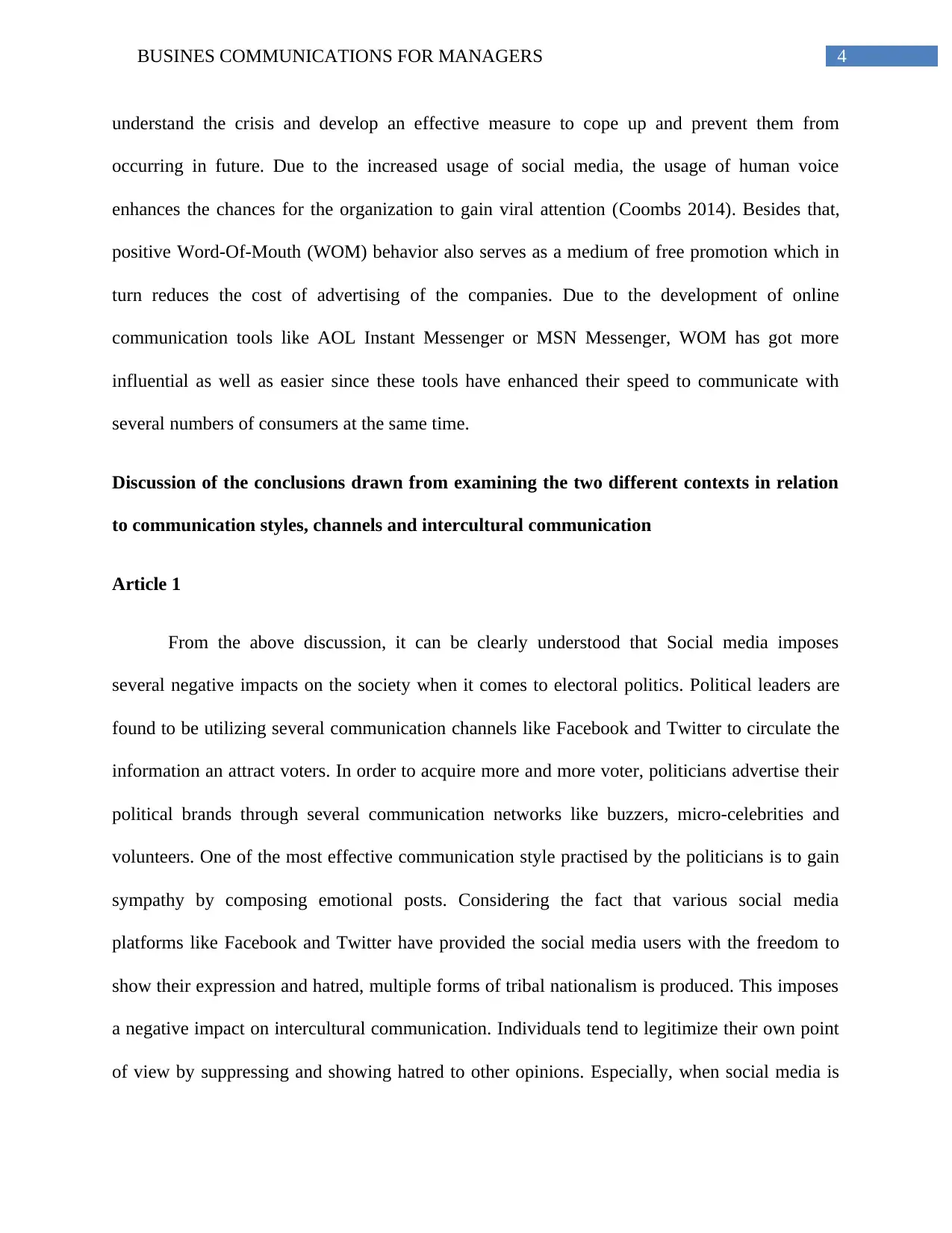
4BUSINES COMMUNICATIONS FOR MANAGERS
understand the crisis and develop an effective measure to cope up and prevent them from
occurring in future. Due to the increased usage of social media, the usage of human voice
enhances the chances for the organization to gain viral attention (Coombs 2014). Besides that,
positive Word-Of-Mouth (WOM) behavior also serves as a medium of free promotion which in
turn reduces the cost of advertising of the companies. Due to the development of online
communication tools like AOL Instant Messenger or MSN Messenger, WOM has got more
influential as well as easier since these tools have enhanced their speed to communicate with
several numbers of consumers at the same time.
Discussion of the conclusions drawn from examining the two different contexts in relation
to communication styles, channels and intercultural communication
Article 1
From the above discussion, it can be clearly understood that Social media imposes
several negative impacts on the society when it comes to electoral politics. Political leaders are
found to be utilizing several communication channels like Facebook and Twitter to circulate the
information an attract voters. In order to acquire more and more voter, politicians advertise their
political brands through several communication networks like buzzers, micro-celebrities and
volunteers. One of the most effective communication style practised by the politicians is to gain
sympathy by composing emotional posts. Considering the fact that various social media
platforms like Facebook and Twitter have provided the social media users with the freedom to
show their expression and hatred, multiple forms of tribal nationalism is produced. This imposes
a negative impact on intercultural communication. Individuals tend to legitimize their own point
of view by suppressing and showing hatred to other opinions. Especially, when social media is
understand the crisis and develop an effective measure to cope up and prevent them from
occurring in future. Due to the increased usage of social media, the usage of human voice
enhances the chances for the organization to gain viral attention (Coombs 2014). Besides that,
positive Word-Of-Mouth (WOM) behavior also serves as a medium of free promotion which in
turn reduces the cost of advertising of the companies. Due to the development of online
communication tools like AOL Instant Messenger or MSN Messenger, WOM has got more
influential as well as easier since these tools have enhanced their speed to communicate with
several numbers of consumers at the same time.
Discussion of the conclusions drawn from examining the two different contexts in relation
to communication styles, channels and intercultural communication
Article 1
From the above discussion, it can be clearly understood that Social media imposes
several negative impacts on the society when it comes to electoral politics. Political leaders are
found to be utilizing several communication channels like Facebook and Twitter to circulate the
information an attract voters. In order to acquire more and more voter, politicians advertise their
political brands through several communication networks like buzzers, micro-celebrities and
volunteers. One of the most effective communication style practised by the politicians is to gain
sympathy by composing emotional posts. Considering the fact that various social media
platforms like Facebook and Twitter have provided the social media users with the freedom to
show their expression and hatred, multiple forms of tribal nationalism is produced. This imposes
a negative impact on intercultural communication. Individuals tend to legitimize their own point
of view by suppressing and showing hatred to other opinions. Especially, when social media is
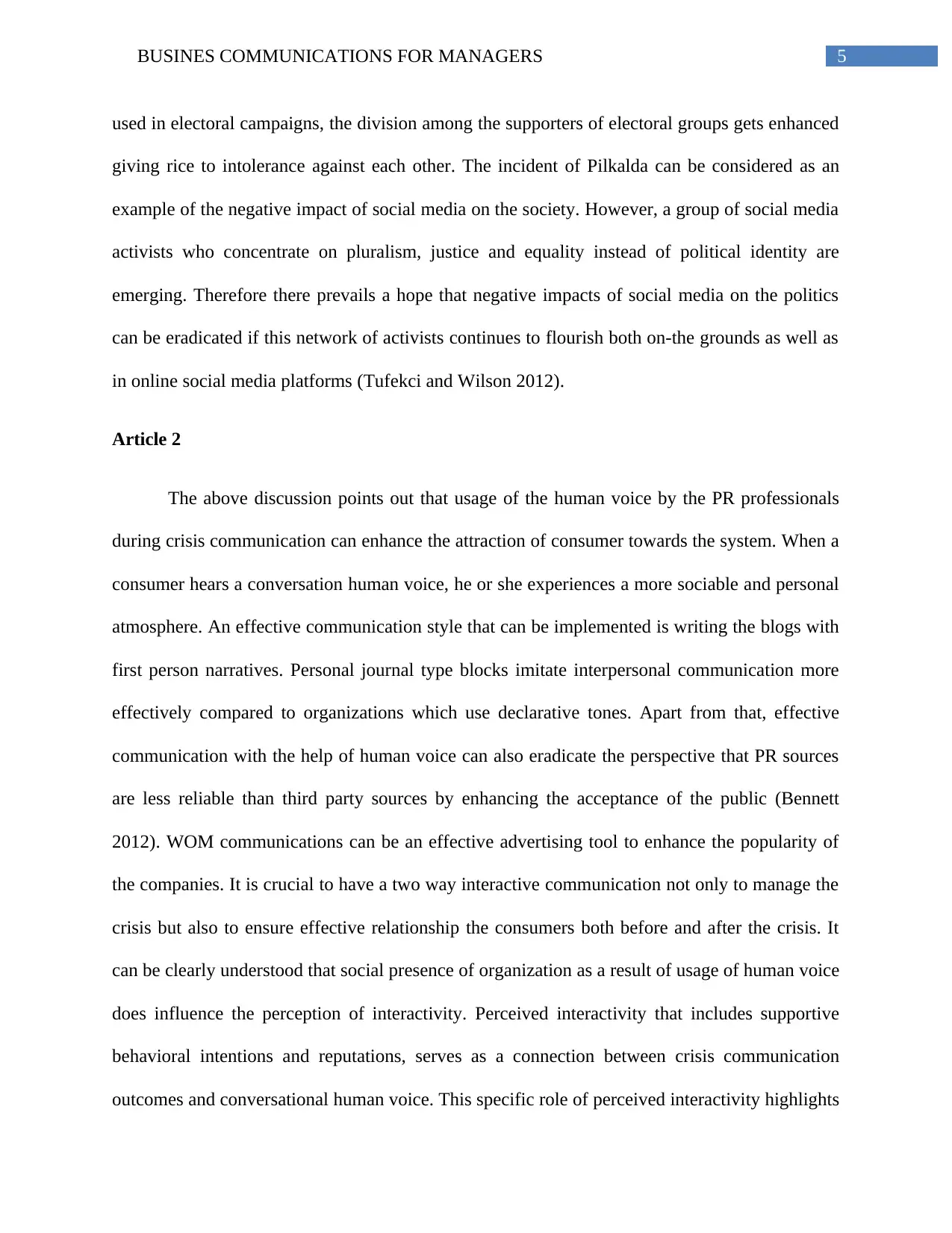
5BUSINES COMMUNICATIONS FOR MANAGERS
used in electoral campaigns, the division among the supporters of electoral groups gets enhanced
giving rice to intolerance against each other. The incident of Pilkalda can be considered as an
example of the negative impact of social media on the society. However, a group of social media
activists who concentrate on pluralism, justice and equality instead of political identity are
emerging. Therefore there prevails a hope that negative impacts of social media on the politics
can be eradicated if this network of activists continues to flourish both on-the grounds as well as
in online social media platforms (Tufekci and Wilson 2012).
Article 2
The above discussion points out that usage of the human voice by the PR professionals
during crisis communication can enhance the attraction of consumer towards the system. When a
consumer hears a conversation human voice, he or she experiences a more sociable and personal
atmosphere. An effective communication style that can be implemented is writing the blogs with
first person narratives. Personal journal type blocks imitate interpersonal communication more
effectively compared to organizations which use declarative tones. Apart from that, effective
communication with the help of human voice can also eradicate the perspective that PR sources
are less reliable than third party sources by enhancing the acceptance of the public (Bennett
2012). WOM communications can be an effective advertising tool to enhance the popularity of
the companies. It is crucial to have a two way interactive communication not only to manage the
crisis but also to ensure effective relationship the consumers both before and after the crisis. It
can be clearly understood that social presence of organization as a result of usage of human voice
does influence the perception of interactivity. Perceived interactivity that includes supportive
behavioral intentions and reputations, serves as a connection between crisis communication
outcomes and conversational human voice. This specific role of perceived interactivity highlights
used in electoral campaigns, the division among the supporters of electoral groups gets enhanced
giving rice to intolerance against each other. The incident of Pilkalda can be considered as an
example of the negative impact of social media on the society. However, a group of social media
activists who concentrate on pluralism, justice and equality instead of political identity are
emerging. Therefore there prevails a hope that negative impacts of social media on the politics
can be eradicated if this network of activists continues to flourish both on-the grounds as well as
in online social media platforms (Tufekci and Wilson 2012).
Article 2
The above discussion points out that usage of the human voice by the PR professionals
during crisis communication can enhance the attraction of consumer towards the system. When a
consumer hears a conversation human voice, he or she experiences a more sociable and personal
atmosphere. An effective communication style that can be implemented is writing the blogs with
first person narratives. Personal journal type blocks imitate interpersonal communication more
effectively compared to organizations which use declarative tones. Apart from that, effective
communication with the help of human voice can also eradicate the perspective that PR sources
are less reliable than third party sources by enhancing the acceptance of the public (Bennett
2012). WOM communications can be an effective advertising tool to enhance the popularity of
the companies. It is crucial to have a two way interactive communication not only to manage the
crisis but also to ensure effective relationship the consumers both before and after the crisis. It
can be clearly understood that social presence of organization as a result of usage of human voice
does influence the perception of interactivity. Perceived interactivity that includes supportive
behavioral intentions and reputations, serves as a connection between crisis communication
outcomes and conversational human voice. This specific role of perceived interactivity highlights
⊘ This is a preview!⊘
Do you want full access?
Subscribe today to unlock all pages.

Trusted by 1+ million students worldwide
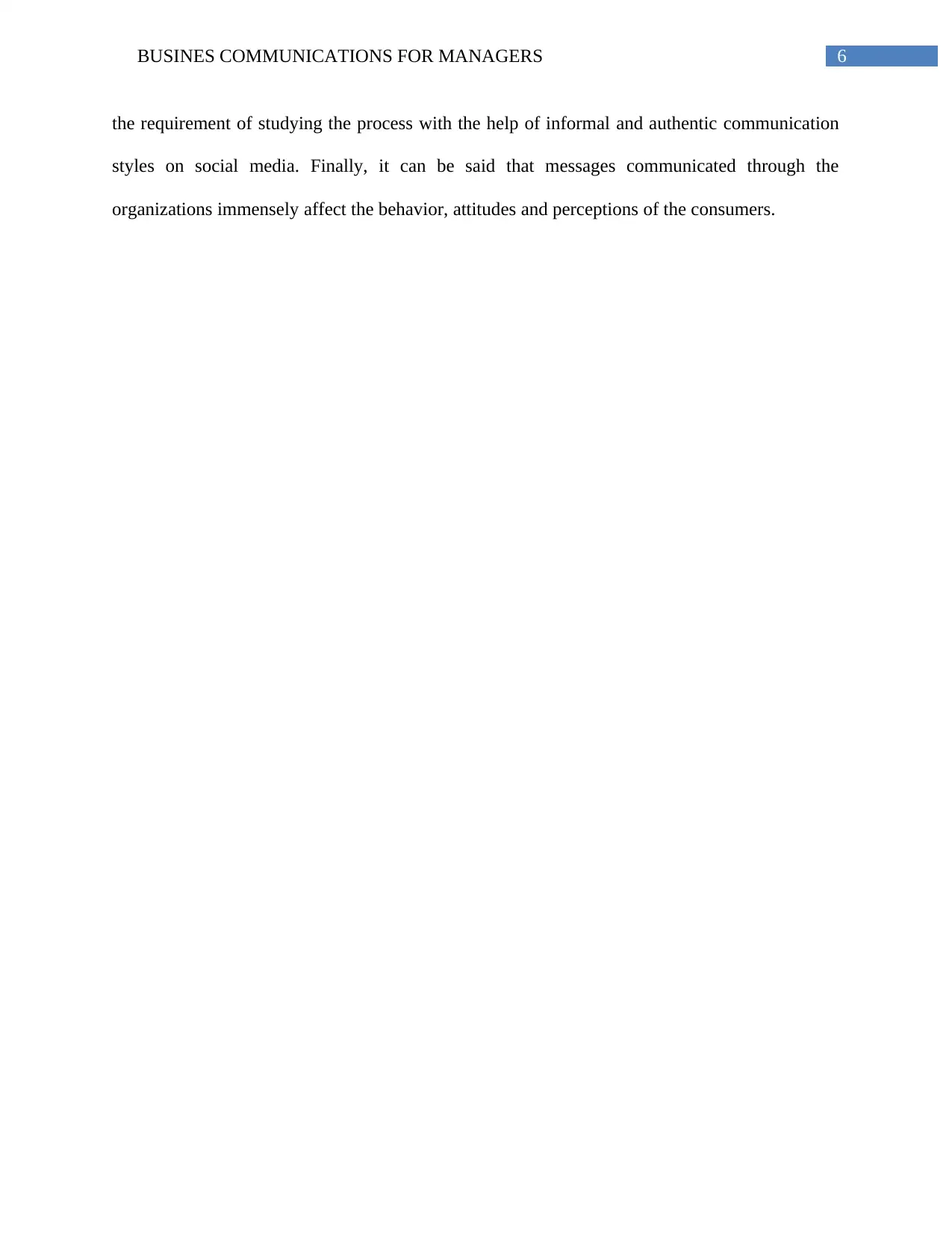
6BUSINES COMMUNICATIONS FOR MANAGERS
the requirement of studying the process with the help of informal and authentic communication
styles on social media. Finally, it can be said that messages communicated through the
organizations immensely affect the behavior, attitudes and perceptions of the consumers.
the requirement of studying the process with the help of informal and authentic communication
styles on social media. Finally, it can be said that messages communicated through the
organizations immensely affect the behavior, attitudes and perceptions of the consumers.
Paraphrase This Document
Need a fresh take? Get an instant paraphrase of this document with our AI Paraphraser
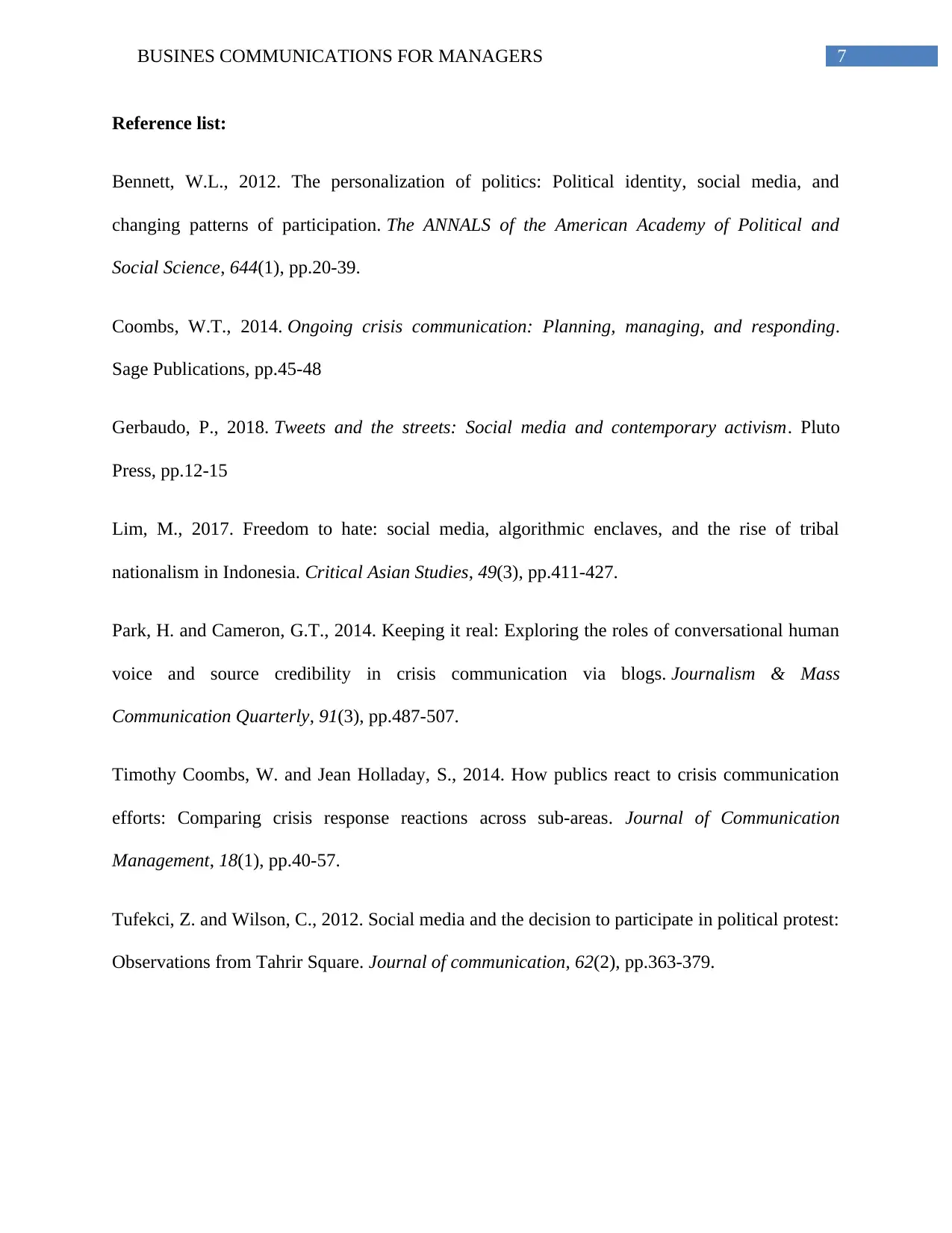
7BUSINES COMMUNICATIONS FOR MANAGERS
Reference list:
Bennett, W.L., 2012. The personalization of politics: Political identity, social media, and
changing patterns of participation. The ANNALS of the American Academy of Political and
Social Science, 644(1), pp.20-39.
Coombs, W.T., 2014. Ongoing crisis communication: Planning, managing, and responding.
Sage Publications, pp.45-48
Gerbaudo, P., 2018. Tweets and the streets: Social media and contemporary activism. Pluto
Press, pp.12-15
Lim, M., 2017. Freedom to hate: social media, algorithmic enclaves, and the rise of tribal
nationalism in Indonesia. Critical Asian Studies, 49(3), pp.411-427.
Park, H. and Cameron, G.T., 2014. Keeping it real: Exploring the roles of conversational human
voice and source credibility in crisis communication via blogs. Journalism & Mass
Communication Quarterly, 91(3), pp.487-507.
Timothy Coombs, W. and Jean Holladay, S., 2014. How publics react to crisis communication
efforts: Comparing crisis response reactions across sub-areas. Journal of Communication
Management, 18(1), pp.40-57.
Tufekci, Z. and Wilson, C., 2012. Social media and the decision to participate in political protest:
Observations from Tahrir Square. Journal of communication, 62(2), pp.363-379.
Reference list:
Bennett, W.L., 2012. The personalization of politics: Political identity, social media, and
changing patterns of participation. The ANNALS of the American Academy of Political and
Social Science, 644(1), pp.20-39.
Coombs, W.T., 2014. Ongoing crisis communication: Planning, managing, and responding.
Sage Publications, pp.45-48
Gerbaudo, P., 2018. Tweets and the streets: Social media and contemporary activism. Pluto
Press, pp.12-15
Lim, M., 2017. Freedom to hate: social media, algorithmic enclaves, and the rise of tribal
nationalism in Indonesia. Critical Asian Studies, 49(3), pp.411-427.
Park, H. and Cameron, G.T., 2014. Keeping it real: Exploring the roles of conversational human
voice and source credibility in crisis communication via blogs. Journalism & Mass
Communication Quarterly, 91(3), pp.487-507.
Timothy Coombs, W. and Jean Holladay, S., 2014. How publics react to crisis communication
efforts: Comparing crisis response reactions across sub-areas. Journal of Communication
Management, 18(1), pp.40-57.
Tufekci, Z. and Wilson, C., 2012. Social media and the decision to participate in political protest:
Observations from Tahrir Square. Journal of communication, 62(2), pp.363-379.
1 out of 8
Your All-in-One AI-Powered Toolkit for Academic Success.
+13062052269
info@desklib.com
Available 24*7 on WhatsApp / Email
![[object Object]](/_next/static/media/star-bottom.7253800d.svg)
Unlock your academic potential
Copyright © 2020–2025 A2Z Services. All Rights Reserved. Developed and managed by ZUCOL.
